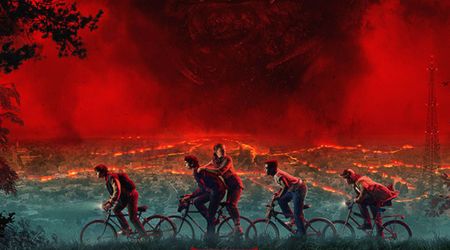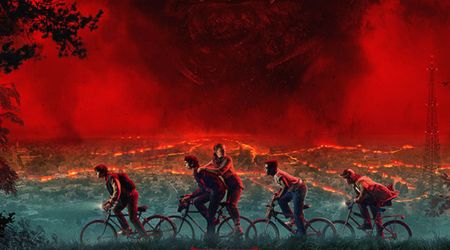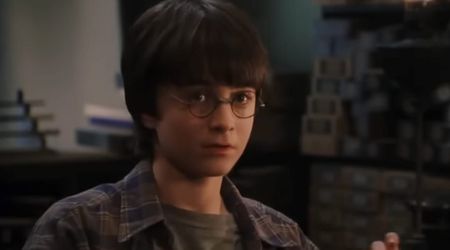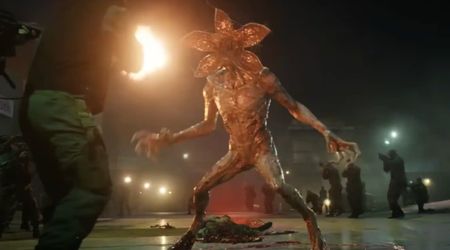'Alien: Romulus': 10 things you need to know about the xenomorph and its origins as it heads back to screens

LOS ANGELES, CALIFORNIA: For fans of Ridley Scott's 'Alien', that iconic scream has reverberated through the corridors of sci-fi history for over four decades.
'Alien' not only catapulted Sigourney Weaver into stardom as the resilient Lt. Ellen Ripley but also established itself as a cornerstone of horror cinema.
While the Alien franchise has branched out into numerous sequels, prequels, and even the contentious 'Alien vs. Predator' crossovers, the origins of its legendary status lie aboard the Nostromo.
It's particularly striking that the terrifying xenomorph appears on screen for just four minutes, yet this is only the tip of the iceberg when it comes to the fascinating details behind the film.
From its groundbreaking special effects to the claustrophobic set designs that amplify the tension, 'Alien' continues to captivate audiences.
Here are 10 lesser-known facts about 'Alien' that reveal the secrets behind its enduring legacy.
1. From 'Star Beast' to 'Alien': How a title change transformed a Sci-Fi horror film

The title 'Alien' has become synonymous with both horror and sci-fi, instantly conjuring the image of the menacing extraterrestrial creature.
However, this iconic name was not the original choice. The film was initially called 'Star Beast,' a name coined by Dan O’Bannon and Ronald Shusett during the early stages of development.
The shift to 'Alien' came about when O’Bannon observed the frequent use of the word in the script and suggested it for its simplicity and impact. This decision mirrored the success of other one-word horror titles like 'It' and 'Scream'.
The name change proved to be a masterstroke, as 'Star Beast' lacked the same punch and gravitas. The atmospheric crawl of the letters 'Alien' on screen is now etched into cinematic history.
In a parallel universe, fans might be eagerly anticipating Noah Hawley’s 'Star Beast' series on FX. However, in this reality, Alien stands as a powerful and enduring brand in the world of horror and science fiction.
2. The surreal genius of H.R. Giger: How his nightmarish art became the blueprint for the Xenomorph in 'Alien'

The Xenomorph, the fearsome antagonist in 'Alien,' owes its iconic appearance to the surreal and nightmarish artwork of HR Giger.
The creature's design was inspired by Giger's 1976 painting 'Necronom IV,' which captivated screenwriter Dan O’Bannon with its unique blend of horror and beauty.
O’Bannon, who had long admired Giger's work, insisted on incorporating his vision into the film, stating in 'The Book of Alien' that he had 'never seen anything that was quite as horrible and at the same time as beautiful as his work.'
Despite initial resistance due to the disturbing nature of Giger's art, director Ridley Scott was convinced of its potential and brought Giger on board.
Giger's influence extended beyond the Xenomorph, as he also contributed to the eerie, industrial design of the alien planet LV-426.
Additionally, the infamous chest-burster scene drew inspiration from Francis Bacon's painting 'Three Studies for Figures at the Base of a Crucifixion,' further cementing the film's unique and unsettling aesthetic.
3. The fascinating casting alternatives for 'Alien' with Harrison Ford and Meryl Streep

The casting of 'Alien' might have looked quite different if initial considerations had come to fruition. Harrison Ford, fresh off the success of 'Star Wars', was offered the role of Captain Dallas but declined, likely to avoid being typecast in another sci-fi role.
The part ultimately went to Tom Skerritt, whose performance contributed significantly to the film's grounded, gritty atmosphere.
Another intriguing 'what if' involves the casting of Ripley. Meryl Streep was considered for the role but had to withdraw due to personal circumstances. This opened the door for Sigourney Weaver, whose portrayal of Ripley became iconic.
The 2000 biography 'Harrison Ford: Imperfect Hero and the Alien Anthology' Blu-ray provides insights into these casting decisions, highlighting how close the film came to having entirely different leads.
These choices underscore the impact of casting on the film's tone and reception, with Weaver's Ripley becoming a trailblazing character in science fiction and horror.
4. Ridley Scott’s daringly dark vision and the Studio’s Decision to Opt for a Hopeful Finale

'Alien' is renowned for its bleak and suspenseful atmosphere, culminating in a tense finale where Ripley, the last human survivor, battles the Xenomorph aboard the lifeboat Narcissus.
She ultimately prevails by blasting the creature out of an airlock and incinerating it with the ship's engines.
However, the original ending conceived by Ridley Scott was even darker. In this alternate version, the Xenomorph would have reboarded the lifeboat, decapitated Ripley, and then used her voice to lure more unsuspecting victims.
This grim conclusion was vetoed by studio executives who feared it would be too depressing and would undermine the potential for sequels.
They threatened to fire Scott if he pursued this ending. The decision to let Ripley survive not only provided a glimmer of hope in an otherwise harrowing film but also paved the way for the franchise to continue.
Scott's compromise preserved the film's integrity while ensuring Ripley’s legacy as a resilient and resourceful heroine in the annals of sci-fi horror.
5. How Ridley Scott’s secrecy about the chestburster scene in 'Alien' led to authentic actor reactions

One of the most unforgettable scenes in 'Alien' is the shocking and gruesome chestburster sequence, where a tiny Xenomorph erupts from the chest of John Hurt's character, Kane. This moment is frequently cited as one of the greatest horror scenes in cinematic history.
To achieve the genuine horror and surprise seen on the actors' faces, director Ridley Scott kept the specifics of the scene largely hidden from the cast.
In a 2009 interview with The Guardian, Sigourney Weaver revealed that the script only vaguely described the event, simply stating, 'This thing emerges.'
This lack of detailed information meant that the cast was largely unprepared for the actual execution of the scene. Scott believed that authentic reactions to terror could only be captured through genuine shock.
Consequently, the actors's responses, including Veronica Cartwright's fainting and Yaphet Kotto's refusal to speak to anyone afterward, were real and unfiltered.
This approach underscored the film's commitment to visceral horror, creating a scene that remains a benchmark for practical effects and unexpected terror in cinema.
6. The literary inspirations behind the names of the Spaceships in Ridley Scott’s Sci-Fi classic

The influence of author Joseph Conrad on the 'Alien' franchise is a testament to Ridley Scott's appreciation for literary depth.
Scott’s adaptation of Conrad's novella 'The Duel' was his first major picture, solidifying his admiration for the Polish-born writer.
This admiration is subtly woven into 'Alien' through the naming of its ships. The Nostromo, the primary vessel in the original film, shares its name with Conrad's 1904 novel, echoing themes of isolation and moral ambiguity.
Similarly, Ripley's lifeboat, the Narcissus, is named after the ship in Conrad's 'The Children of the Sea.'
7. The physical toll of Spacesuits and Sweltering heat on the cast and crew

The filming of 'Alien' was notorious for its challenging and often harsh conditions, especially due to the cumbersome spacesuits worn by the cast.
These suits, lined with nylon and initially lacking proper ventilation, caused significant discomfort and health issues for the cast. The set was plagued by sweltering heat, which made the already difficult conditions even more unbearable.
The lack of ventilation in the suits meant that carbon dioxide levels could build up dangerously, leading to frequent instances where actors nearly passed out. Nurses were on set with oxygen tanks to provide relief.
The turning point came when Ridley Scott and cinematographer Dennis Vanlint’s sons, who were extras, nearly fainted.
This incident prompted modifications to the suits to include better ventilation. Despite these improvements, the conditions remained tough.
Tom Skerritt, who played Captain Dallas, later remarked that while the suits were indeed uncomfortable, working with a director of Scott’s caliber made it worthwhile.
This dedication to authenticity, despite the physical toll, contributed to the film’s immersive and claustrophobic atmosphere, enhancing its tension and realism.
8. How gender-neutral casting choices led to Sigourney Weaver’s groundbreaking role as Ripley in 'Alien'

The casting process for 'Alien' was unique in its initial approach to the characters as gender-neutral, allowing for a wide range of possibilities.
Ridley Scott and the casting team envisioned the roles of Dallas, Lambert, Ripley, and others as interchangeable, focusing on finding the right actors rather than adhering to gender norms.
This flexibility is evident in the original script, which referred to the crew members simply by their names without specifying gender.
This approach was groundbreaking for its time and allowed for a more diverse casting pool. However, Scott initially imagined Ripley as a male character, fitting the typical action-hero mold of the era.
It was 20th Century Fox President Alan Ladd who suggested making Ripley a woman, a decision that would redefine the role of women in sci-fi and horror. Scott embraced this idea, leading to Sigourney Weaver's casting as Ripley.
This decision not only added a fresh dynamic to the film but also established Ripley as one of the most iconic and influential female characters in cinema history, paving the way for stronger female leads in future genres.
9. How the 6'10” Nigerian student became the iconic Xenomorph in Ridley Scott’s 'Alien'

The portrayal of the Xenomorph in 'Alien' is a critical aspect of the film's enduring legacy, and Nigerian student Bolaji Badejo played a pivotal role in bringing this terrifying creature to life.
Standing at an imposing 6'10", Badejo was discovered by the casting team in a Soho bar, chosen for his unique physicality, which fit the vision of the Xenomorph as a tall, slender, and otherworldly being.
Despite competing with Peter Mayhew, known for his role as Chewbacca, Badejo's physique was deemed perfect for the role. Although Ridley Scott initially preferred using animatronics to avoid the look of 'a man in a suit,' the technology at the time was insufficient.
Badejo's performance required significant physical endurance, especially during the final fight scenes where the cramped set conditions added to the challenge.
Notably, Scott avoided front-facing shots of the Xenomorph to maintain its alien mystique. Despite his significant contribution, Badejo chose not to return for the sequels, returning to Nigeria in 1980.
His work, however, remains a cornerstone of the film's impact, with his portrayal of the Xenom.
10. Behind the scenes of the Nostromo’s feline survivor

Ripley’s escape from the Nostromo wasn’t a solitary affair; she was accompanied by Jones, the ship's resident feline. While the real-life Jones died long ago, his on-screen legacy endures.
Notably, four different cats were used to portray Jones, each with specific roles: one for holding, one for hissing, and so on.
Comedian Sooz Kempner revealed her childhood connection to one of these cats, sharing a photo of 'Boris' to authenticate his role as Jones.
In a memorable scene, Jones's reaction to the Xenomorph was achieved by using a German Shepherd to provoke the cats.
Adding to the film's behind-the-scenes anecdotes, Sigourney Weaver initially believed she was allergic to cats due to a rash she developed.
In reality, it was just a reaction to glycerin used to make her appear sweaty. The dedication to authenticity, both with furry and human cast members, added depth to the film’s intense atmosphere.
'Alien' is available for streaming on Prime Video.










